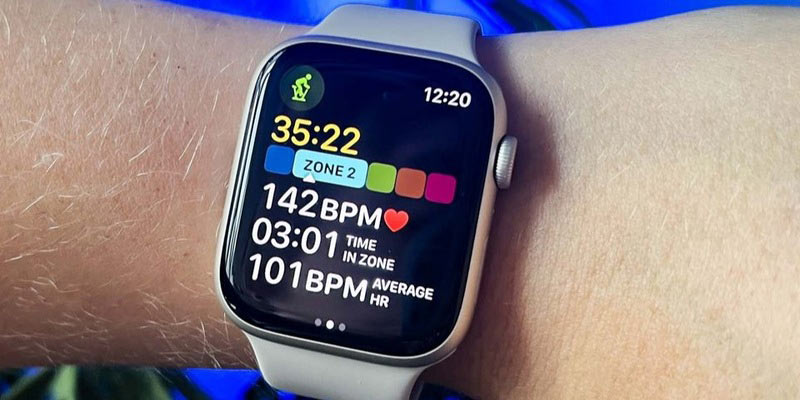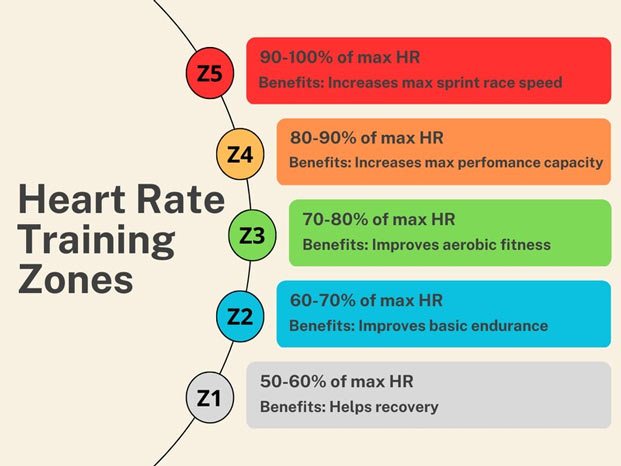
Do you ever ponder the methods to amplify your workout's effectiveness? Understanding and employing Target Heart Rate Zones hold the key. Your heart rate serves as a potent gauge for exercise intensity. Hence, customizing efforts within specific zones can unleash numerous advantages. Let's explore how you can optimize your fitness routine for better results.
Benefits of Target Heart Rate Training
Optimizing fat burning is a key aspect of Unlocking the Benefits of Target Heart Rate Training. When you exercise in the fat-burning zone, it promotes weight loss by encouraging sustained effort at a moderate intensity and allows your body to use fat as its primary energy source. This targeted utilization not only aids in managing weight but also boosts metabolic efficiency, thereby supporting overall health. Moreover, training within your aerobic zone enhances cardiovascular health and fosters superior oxygen utilization by your body. It’s an effective strategy for enhancing endurance over time.
Incorporating Target Heart Rate Zones into your fitness regimen enhances not only stamina but also mental resilience, thus fostering a comprehensive approach to exercise. The multifaceted advantages underscore how crucial it is to engage in endurance training at higher heart rate zones for a well-rounded and potent fitness profile.
Understanding your target heart rate zones can yield not only physical benefits but also enhance mental well-being. The mindfulness necessary to remain within specific heart rate ranges nurtures a profound bond between body and mind during exercise, thereby fostering mental concentration and diminishing stress levels. This deliberate strategy towards fitness amplifies the comprehensive workout experience while concurrently bolstering long-term psychological health.
- Holistic Approach: Target heart rate training offers a holistic approach, benefiting both physical and mental well-being.
- Metabolic Efficiency: Exercising in the fat-burning zone enhances metabolic efficiency, supporting weight management and overall health.
Tailoring Workouts to Specific Zones
You have grasped the benefits. Now, we shall delve into applying this knowledge to your workouts. Activities such as walking or yoga, are ideal for warm-ups and cool-downs in Zone 1, which corresponds to a Resting Heart Rate of 50-60% of your maximum HR. Contribute not just towards preparing your body for more strenuous exercises but also enhance flexibility while inducing relaxation. These low-intensity exercises play a dual role. They prime you for higher-intensity activities and promote both flexibility as well as relaxation. Transitioning to Zone 2, the Fat-Burning zone at a heart rate of 60-70% your maximum, you should incorporate activities such as brisk walking, light jogging, or cycling. This not only aids in weight loss. It also permits a gradual increase in heart rate, thus ensuring an effortless transition between zones.

Let's proceed to Zone 3, the Aerobic zone. Here, by engaging in activities such as running, swimming, and high-intensity interval training (HIIT), all of which operate optimally at 70-80% of your Maximum Heart Rate (Max HR), you can significantly enhance cardiovascular fitness. This mid-range intensity presents a challenge for both your heart and lungs. Consequently, promoting endurance while amplifying overall aerobic capacity. If we advance even further into Zone 4, the Anaerobic zone operating within an intensity range from 80%-90% Max HR, we can incorporate sprinting along with interval training.
These activities serve to elevate anaerobic fitness levels substantially thereby enhancing performance significantly. This zone propels you to your limits. It enhances power and speed. In Zone 5, the Maximum Effort zone, where activity levels surge to 90-100% of maximum heart rate, explosive actions like sprinting are reserved for brief bursts. This strategy fosters the development of peak power and velocity. Employing these zones strategically within your workout routine guarantees a comprehensive approach focused on goals in fitness.
- Flexibility and Relaxation: Low-intensity exercises in Zone 1, like walking or yoga, contribute to flexibility and relaxation.
- Comprehensive Approach: Strategically utilizing different heart rate zones ensures a comprehensive and goal-oriented approach to fitness.
Listening to Your Body - Important Considerations
Target heart rate zones offer valuable guidance. However, you must crucially attend to their bodily sensations during exercise. Stress, fatigue, and individual variations can indeed influence your heart rate. These are factors that demand careful consideration. Adjusting intensity, without hesitation, is imperative based on daily feelings. It is an essential aspect of maintaining optimal health and performance levels. Incorporating a variety of exercises, which align with different heart rate zones, not only ensures a well-rounded fitness routine. It also prevents monotony and promotes overall engagement in physical activity.
Optimizing your workout and preventing burnout, as well as injuries, necessitates a fundamental understanding of your body's response to varying intensities. By consistently evaluating how different heart rate zones elicit reactions from your body, you can make adjustments that guarantee an enjoyable and sustainable fitness journey.
- Variety Matters: Incorporate a variety of exercises aligned with different heart rate zones for a well-rounded fitness routine.
- Preventing Burnout: Regularly assessing your body's response to different intensities helps prevent burnout and injuries.
Optimizing Recovery - The Role of Resting Heart Rate
To optimize recovery and overall health, one must crucially understand their Resting Heart Rate (RHR). The Resting Heart Rate provides valuable insights into cardiovascular fitness by representing the number of heartbeats per minute during complete body rest. Over time, monitoring your RHR can offer clues about both your general well-being and the effectiveness of a training routine. A lower resting heart rate (RHR) often signifies superior cardiovascular fitness: it suggests that your heart, during periods of rest, experiences less strain.

Your Resting Heart Rate (RHR), beyond being a cardiovascular health indicator, serves as a crucial element in your workout planning. Intense training periods can elevate your RHR, potentially signaling fatigue or overtraining. By acknowledging and understanding these fluctuations, you strategically adjust exercise intensity and recovery protocols accordingly. When you integrate rest days or engage in lighter activities during periods of elevated RHR, you can prevent burnout and mitigate injury risks. Furthermore, a vigilant focus on your RHR yields an all-encompassing comprehension of your body's reactions to exercise and stress; this empowers informed decisions about workout timing and intensity.
- Overtraining Indicator: An elevated RHR can be a sign of overtraining, prompting the need for strategic adjustments in your workout routine.
- Recovery Planning: Monitoring RHR helps in planning rest days or lighter activities to optimize recovery and prevent burnout.
In Conclusion
Implementing and understanding Target Heart Rate Zones can elevate your fitness journey significantly. This approach, applicable whether you're a beginner or seasoned athlete, injects a personalized touch into your exercise routine, thereby enhancing its efficiency and enjoyment. Keep this in mind the next time you venture into the gym or set off on a run: paying attention to your heart rate zones will unleash a transformation in your fitness levels.



